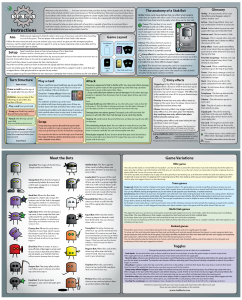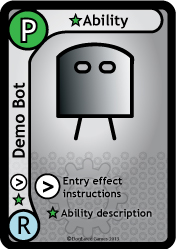Watch the video to learn how to play the standard game, or scroll down for written instructions.
Once you’re familiar with the standard game, you may want to look at some more advanced ways to play here, or at some different game variations here!
Click below to view the original instruction sheet in a new window, or download it as a PDF.
Instructions
You can also view these instructions in German, Dutch or Italian.
Aim
Reduce your opponent’s Stak of cards to zero (even if they have cards left in their hand they are out of the game). The last player with cards left in their Stak is the winner.
Follow the turn structure and carry out actions (play, scrap, attack) to give you the strongest position; choose a card to attack with, play cards to support it, scrap as many opposing cards as possible and try not to leave yourself open to attack.
Setup
- Deal 9 cards face-down in front of each player. This is their Stak. (Deal less cards for a shorter game, or if there are a lot of players).
- Players then turn the top card of their Stak to face-up. (During the game, the top card must always be turned to face-up. Note that entry effects shown on the cards do not apply during the setup).
- Deal 2 cards face-down to each player for their starting hand.
- Place the rest of the cards face-down to become the supply pile from which all players draw.
- Leave an empty space for the scrapheap (cards that are discarded from a player’s hand or cards that get scrapped from a Stak get placed face-up here in any order).
- Select a player to go first and follow the turn structure. Gameplay then moves clockwise to the next player.
Turn Structure
- Start of turn
- Draw a card from the top of the supply pile into your hand
- Actions: carry out any of the following, in any order, any number of times:
- Play a card from your hand
- Scrap your Stak’s top card or discard from your hand
- Attack with the top card of your Stak (only one attacking card per turn)
- Feed the scrapheap: at least one card (from any player) has to enter the scrapheap before your turn can end
- End of Turn
The Actions Explained
Play a Card
Place a card from your hand face-up on your Stak: It becomes your new top card. Place it so you can see the sidebar of the card below it. Check for entry effects: Follow the instructions on the card immediately.
Note:
The sidebars of all face-up cards must be visible at all times during play, even if they are further down the Stak and below face-down cards. Combining entry effects with attacks is key to victory, so think carefully about when to play cards, in what order and which card to choose as your attacking card.
Scrap
Scrap your top card or discard from your hand: If you are unable to scrap an opponent’s card you may end up having to do this to feed the scrapheap. You may also do this to work through your Stak with the hope of finding a better attacking card, or a card with a helpful entry effect.
Attack
Choose an opponent’s Stak to battle with: Your top card inflicts damage equal to its power value to the opponent’s top card; their top card does the same to yours at the same time. Then…
…Scrap cards that have taken too much damage: If a Bot takes damage equal to or greater than its power, then it scraps; place it face-up in the scrapheap.
Note:
- Damage builds up over the turn:
- eg. Your Bot with power 5 attacks their Bot with power 2. Their Bot takes 5 damage and scraps. Your Bot takes 2 damage. If your Bot takes a further 3 or more damage this turn then it will scrap.
- Damage does not reduce power:
- Damaged cards still have their full power, so will still inflict their full damage to any cards they battle.
- Healing:
- All cards heal at the end of the turn, so they start each turn with no damage.
- One attacking card per turn:
- You can attack as many times as you like during your turn, but you have to use the same card to attack with each time so choose carefully. You can choose again next turn.
- Attack gets stopped:
- If your chosen attack Bot gets reset (turned facedown), returned to your hand or if it scraps, then you can no longer attack with it this turn.
Entry effects
- Triggering:
- Entry effects trigger as soon as a card is played from a hand, or when it turns face-up at the top of its Stak (if it is already face-up and then becomes a top card, it doesn’t trigger). The effect has to be carried out, even if it is to your disadvantage or it is not your turn.
- Priority:
- If more than one entry effect needs to trigger at the same time, the player whose turn it is plays first and the others wait.
- Chains:
- One entry effect may trigger another entry effect; if so, this takes place immediately.
Any resulting new entry effects take place before already waiting ones.
If a waiting entry effect card stops being the top card then it does not trigger.
Also note, in the rare event that a player’s Stak has just run out but an entry effect chain is still happening, the chain continues and must finish before they are out of the game.
The anatomy of a Stak Bot
- Ability:
- Some cards have abilities that can affect what happens when they do battle with other cards. These are detailed on the cards that have them and only apply when they are the top card.
- This shows the Bot’s name as well as little reminder symbols so you can see what the card’s abilities and effects are when it is partially covered.
- Entry effect:
- If a card has this symbol, follow the instructions as soon as it enters play from your hand or turns face-up at the top of its Stak. It doesn’t matter whose turn it is, or whether or not it is helpful to you, these effects always trigger.
- Rank:
- This shows how strong the card is in comparison to other cards but does not normally affect gameplay. (This allows you to setup a game where each player has cards of similar strengths. See the game variations overleaf ).
- Power:
- This number is how much damage a card can inflict during a battle with another card, as well as how much damage it can take before it scraps. eg. A power 4 card can deal 4 damage to every card it battles; if it takes 4 or more damage in a turn it will scrap.


